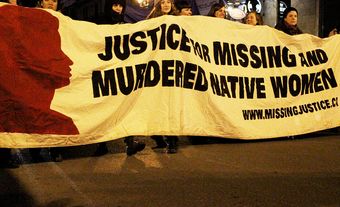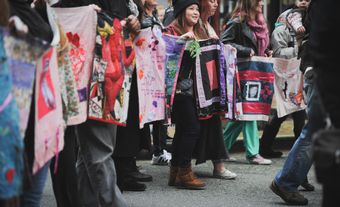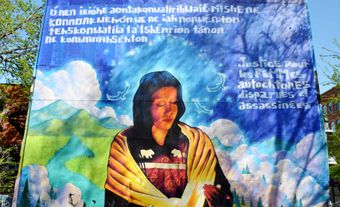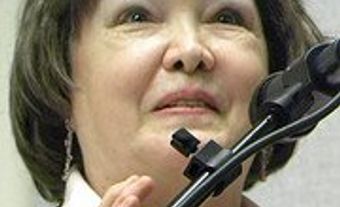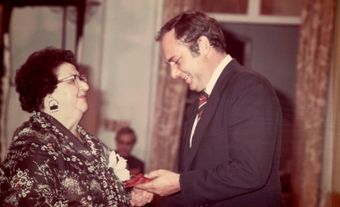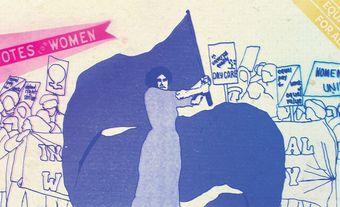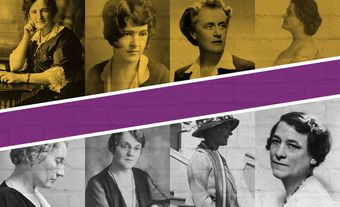First Nations, Métis and Inuit women (collectively referred to as Indigenous women) face many socio-economic issues today because of the effects of colonization. Europeans forced a male-controlled system of government and society (known as patriarchy) on Indigenous societies. The 1876 Indian Act disadvantaged certain Indigenous women by excluding them from band council government and enforcing discriminatory measures that took away Indian Status rights. Many Indigenous women today are leading the way in the area of healing the wounds of colonization, as they grapple with the issues of residential schools, missing and murdered Indigenous women and girls, abuse and violence, and drug, alcohol and other addictions. (See also Indigenous Feminisms in Canada.)
Common Concerns
Despite differences among First Nations, Métis and Inuit communities, Indigenous women have some common concerns with the Indigenous population as a whole, many of which stem from European colonization. In addition to the loss of their territories in the 19th century, Indigenous people also lost their traditional livelihood and self-sufficiency. Moreover, social, economic and political marginalization, as well as racial stereotyping, discrimination, and the loss of culture, language and often pride, left Indigenous people in Canada with little social or political power. This contributed to economic inequality and even poverty. Urban and rural Indigenous communities continue to struggle with a lack of education, employment, skills, opportunities and income equity. (See also Economic Conditions of Indigenous Peoples in Canada and Social Conditions of Indigenous Peoples in Canada.)
Demographic Characteristics
According to the 2016 census, Indigenous people make up 4.9 per cent of the total population of Canada. The Indigenous population is growing rapidly, with a 45 per cent increase between 1996 and 2006. In 2016, Statistics Canada reported the population has increased 42.5 per cent since 2006. (See also Demography of Indigenous Peoples in Canada.)
Although mortality rates have improved over the last two decades, life expectancy for Indigenous people is less than that of the overall Canadian population. Indigenous people also continue to suffer a higher infant mortality rate. Indigenous mortality and fertility rates show a slow trend toward convergence with the Canadian rates. (See also Health of Indigenous Peoples in Canada.)
More young Indigenous women migrate to urban centres than do men, especially from small northern communities. This migration may be caused by the lack of opportunities for advancement on reserves and in rural areas as well as the perceived abundance of opportunities, particularly education, in urban centres. Studies also show that many of these young women are single parents. (See also Urban Migration of Indigenous Peoples in Canada.)
Poverty, single parenthood, unemployment and poor housing continue to affect Indigenous women in Canada. These concerns are often more acute in the North, where rural, isolated communities of Inuit, Métis and First Nations people generally suffer higher rates of illness and have fewer services for the well-being and protection of women and children.
Women and the Indian Act
The Indian Act is federal legislation that pertains to First Nations people. (Inuit and Métis do not fall under the Act.) Until 1985, the Indian Act took away the rights of women with Indian Status if they married someone without status. Bill C-31 changed the Act in that year by bringing it in line with the Canadian Charter of Rights and Freedoms. The 1985 amendment allows women who "married out" — and those who lost their Indian Status by other means — to apply for the restoration of their status and rights. Bill C-31 also allows their children to apply for registration as Status Indians. The Act no longer requires or allows women to follow their husbands into or out of status.
Since the amendments to the Indian Act in 1985, the number of registered Indians has more than doubled, from approximately 360,000 in 1985 to more than 778,000 in 2007. The increase is a result of more births over deaths as well as through "reinstated" Indian Status.
However, while the amendment addressed discrimination against women, it also created some problems. By placing these women, and often their children, onto First Nations band membership lists, the government stretched already limited lands and funds to serve more people. This has, at times, caused resentment and backlash toward these people by First Nations members.
Further, Bill C-31 created two categories of Indian registration that have had consequences on the number of people entitled to Status Rights. The first, known as sub-section 6(1), applies when both parents are or were entitled to registration. The second, known as sub-section 6(2), applies when one parent is entitled to registration under 6(1). Status cannot be transferred if that one parent is registered under sub-section 6(2). In short, after two generations of intermarriage with non-status partners, children would no longer be eligible for status. This is known as the “Second-Generation Cut-Off” rule. The amendment therefore significantly limits the ability to transfer status to one’s children.
Many Indigenous peoples have brought cases against the Indian Act to Canadian courts, including the Bedard case (1971), Lavell case (1973), McIvor case (2007) and Descheneaux case (2015). In 2017, Parliament passed Bill S-3, an Act to eliminate sex-based inequities in Indian registration.
Stereotypes, Violence and the Justice System
Indigenous women have confronted unique problems stemming from stereotypes of them perpetuated by non-Indigenous men since contact. The image of the “Indian princess” gave way to that of the promiscuous "squaw" which rendered Indigenous women vulnerable to violence and mistreatment. Early observations and oral history indicate that widespread violence accompanied the colonization of North America. The removal of Indigenous people from their land, their placement on reserves and the loss of the traditional male roles of hunter-provider have caused role conflicts, frustration and anger which often finds its outlet in violence against women.
The cycle of violence, combined with the poverty and deprivation facing many Indigenous people in Canada, is connected to a higher rate of incidents involving the law than the general population. Simple failure to pay fines accounts for many incarcerations. Lack of resources and few choices often result in limited recourse for Indigenous women. (See also Indigenous Peoples in Canadian Law.)
High rates of domestic violence afflict Indigenous women throughout North America. The Aboriginal Justice Inquiry of Manitoba (1990) noted that one in three Indigenous women suffered abuse at the hands of her partner. The findings from the Royal Commission on Aboriginal Peoples (1996) supported the view that the constant challenges to the culture and collective identity of Indigenous people weakened the communities and contributed to group and individual alienation that led some to self-destruction and anti-social behaviour. In 2014, Indigenous women were nearly three times as likely to report being a victim of spousal violence as non-Indigenous women.
Missing and Murdered Indigenous Women and Girls

Although Indigenous women make up about 4 per cent of the female Canadian population, they are significantly overrepresented among missing and murdered women. ( See also Highway of Tears.)
The issue gained increased awareness and attention after Amnesty International published Stolen Sisters: A Human Rights Response to Violence and Discrimination against Indigenous Women in Canada (2004) and No More Stolen Sisters (2009). Research conducted by the Native Women's Association of Canada (NWAC) established a database of missing and murdered Indigenous women and girls. In 2011, the NWAC database included 582 known cases, most of which had occurred between 1990 and 2010.
In 2013, the RCMP launched an investigation into the problem of missing and murdered Indigenous women in Canada. The report (published in 2014) revealed that from 1980 to 2012, a total of 1,181 Indigenous women were murdered or were considered missing. As of September 2013, 164 Indigenous women were considered missing, 11.3 per cent of all missing women in Canada. As Indigenous women comprise 4 per cent of the entire female population in Canada, this number is disproportionately high. More striking was the revelation that 1,017 Indigenous women had been murdered in this period — 16 per cent of the total for all women homicides in Canada.
In the wake of the RCMP report, calls for a national inquiry into the problem increased. However, the federal government only launched a national public inquiry on 8 December 2015.
The National Inquiry’s final report was completed and presented to the public on 3 June 2019. It declared violence against Indigenous women and girls “a national tragedy of epic proportion.” The commissioners called for a new era in relations between Indigenous women, girls, LBGTQ+ (see also Two Spirit) and the Canadian people — a relationship centred on the empowerment of Indigenous women and girls. (See also Missing and Murdered Indigenous Women and Girls in Canada.)
Sterilization of Indigenous Women
Sterilization has been imposed on Indigenous women in Canada. Sexual sterilization legislation was passed in Alberta (1928–72) and British Columbia (1933–73), and increasingly targeted Indigenous women. Coerced sterilization of Indigenous women took place both within and outside existing legislation, and in federally operated Indian hospitals. The practice has continued into the 21st century. Approximately 100 Indigenous women have alleged that they were pressured to consent to sterilization between the 1970s and 2018, often while in the vulnerable state of pregnancy or childbirth. ( See also Sterilization of Indigenous Women in Canada.)
Indigenous Women and Politics
While many Indigenous women share goals for the advancement of their people, their voices are often ignored by the Indigenous leadership and male-dominated political organizations. During the Canadian Constitution talks of 1992, the independent national Native Women's Association of Canada was not granted a seat to take part in the talks with the federal government, provincial premiers and the four major Indigenous organizations.
Other Indigenous women's organizations formed as dependent adjuncts to the national and regional bodies including the Métis National Council of Women (now Women of the Métis Nation) and the Saskatchewan Indian Women’s Association (now the Saskatchewan First Nations’ Women’s Commission). There are many small grassroots-oriented regional and local women's groups which receive little funding and therefore have difficulty operating in and serving Indigenous communities.
In 2012, there were 111 women chiefs out of 633 First Nations across Canada. Although the percentage of female Indigenous chiefs in 2012 was only 17.5 per cent, this was slightly higher than the percentage of female mayors of Canadian cities. Some of the earliest high-profile Indigenous women include: Rosemarie Kuptana, president of the Inuit Tapiriit Kanatami, Mary Simon of the Inuit Circumpolar Council, and Wendy Grant-John, the first woman to be elected Assembly of First Nations Regional Chief for British Columbia.
Women in Leadership Roles
A growing number of Indigenous women have held leadership roles in regional and national political organizations. Nellie Cournoyea, a Northwest Territories MLA, became the first female premier of a Canadian territory (1991–95), and Ethel Blondin-Andrew was a Member of Parliament until 2006. Elected as a Conservative MP for Nunavut in 2008, Leona Aglukkaq became the first Inuk to be sworn into the Federal Cabinet when she was appointed Minister of Health. Aglukkaq stepped down from that post in 2012 to become the Chair of the (eight-nation) Arctic Council. Shelly Glover, a Manitoba Métis, was first elected in 2008 to represent Saint Boniface as an MP, and is the first policewoman in Canadian Parliamentary history. In 2013, she was appointed Minister of Canadian Heritage and Official Languages. In 2019, Mumilaaq Qaqqaq, Inuk Member of Parliament, became, at age 25, Nunavut’s youngest MP in history, and the first from the New Democratic Party (NDP) since Nunavut became a territory in 1999.
Additionally, many Indigenous women today are leading the way in the area of healing the wounds of colonization, as they grapple with the issues of residential schools, missing and murdered Indigenous women and girls, abuse and violence, and drug, alcohol and other addictions. (See also Indigenous Feminisms in Canada.)

 Share on Facebook
Share on Facebook Share on X
Share on X Share by Email
Share by Email Share on Google Classroom
Share on Google Classroom



